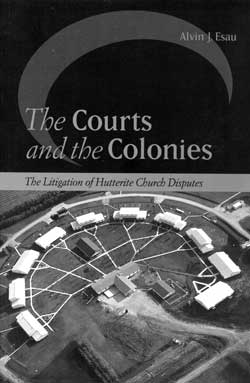by Royden Loewen
University of Winnipeg
|

Scholarship on the Hutterites tends to focus on their early centuries of religious discovery or on the social counters of modern colony or communalist life. Esau’s book cuts a different path. It is a remarkable exposé of conflict in the worlds of mostly Manitoba Hutterites during the 1980s and 1990s. Combing through court records, but also employing other sources including newspaper articles, personal correspondence, and minutes of Hutterian church meetings, Esau reconstructs in minute detail a two-decade long ecclesiastical battle. In the process the author, a law professor, introduces a fascinating discussion on the correct role of the courts in resolving religious conflict; indeed the book reads as a lengthy, careful and precise case study that law students might use in their training. For the historian, however, the book does much more than raise legal questions. It even takes the reader beyond sociologist Donald Kraybill’s back-cover promise of a “rare view inside Hutterite life and conflict.” The book introduces a fascinating set of historical figures, set in a titanic clash of cultures, that is, pre-industrial Christian idealism pitted against a modern, industrial and integrated world.
The book begins in the 1980s when Bishop Jacob Kleinsasser, head of the one hundred-colony Schmiedeleut Hutterian conference centered in Manitoba, and other ministers, moved to discipline one of those colonies, the small clan-based Lakeside Colony, located near Headingly, just west of Winnipeg. The discipline brought in an overseer committee and demoted particular individuals, including firebrand colony secretary, Danny Hofer Sr, eventually assigned to the colony’s stainless steel shop. Tensions rose, the conflict broadened, excommunications followed and it all soon became litigious. One colony charged another with patent infringement; the bishop sought court orders to enforce excommunications; the disciplined members countersued and accused the bishop of astonishing illegalities; and soon the full range of Canadian law, from RCMP officers to a variety of Winnipeg law offices to the Canada’s Supreme Court, joined in the fray.
Esau’s careful and trained eye records this conflict in detail, making it a book one cannot but read page by page. It is a horrible story of the bitterest of human conflict. This book reverberates with the struggle between Bishop Kleinsasser’s people and those associated with Ex-secretary Hofer Sr. It pits cousin against cousin in battles that sometimes turn violent. It spills over into a blizzard of court cases and legal motions, resulting in a landmark Supreme Court of Canada decision that does nothing to quell the discord. It causes a major church schism that tears the Schmiedeleut conference in half, turning numerous colonies into sub-arenas of litigious conflict. It cuts the Bruderhof colonies of eastern America from the three other western-based conferences. And it is all quite distressing to us outsiders who oftentimes applaud the noble Hutterite experiment of contesting individualism and capitalist greed, all the while adapting to modern society. Clearly Esau himself, raised a Mennonite, is distressed by the fundamental derailment of long held Anabaptist principles of non-resistance and separation of true Christian community from coercion and individual gain. In fact Esau argues that the courts, representing an “outside law” have no business adjudicating “inside law.” They only serve to keep contestants from imaginative and thorough reconciliation and, as in the case of the Supreme Court’s decision, often backfire on the victors and only heighten the anger. In the end historians of Manitoba, of church history, of minority-majority relations, of rural society, of ethno-religious history, or of western Canada, will have their own questions. The book is strong on detail and in posing legal questions, but the historian’s quest to understand all the intricacies of the “why” of the story awaits further consideration. Was the conflict inevitable as finite farmland and supply-management quotas limited agrarian options for Hutterites and sent them into manufacturing, a process in which communalist idealists become integrated into a broad, rough urban-based world of credit, patents, market share and distribution networks? And can one make such a transition without assuming an associated culture of individualism, especially of property and ownership of the means of production? Has Hutterian insularity and idealism created the unrelenting stubborn (or principled) streak seen in Kleinsasser, Hofer and dozens of other compelling historical characters? And what was the personal effect in daily life: this book is about the public faces – the male leaders and unbaptized rowdies – and one only imagine the heartfelt, palpable grief among the voiceless – the women, children, elderly – as they are ordered to leave the colony and be separated from kith and kin. The question that is perhaps the most intriguing relates to the nature of the deeply-rooted Hutterian culture that allowed these colonies not only to survive these tumultuous times, but adapt and prosper. In the end one cannot but observe that despite the horrific legal battles, these idealistic communalists did survive, seemingly all the more articulate, more outgoing and even more outspoken in their faith. Is it possible that this struggle helped give birth to a new post-agrarian Hutterian society, one in which a conflict created a new generation of committed and articulate communal idealists? Only time will tell.
Hutterite school children, circa 1922.
Source: Archives of Manitoba, Public Health 126, N15605.
Page revised: 16 June 2012